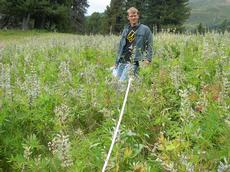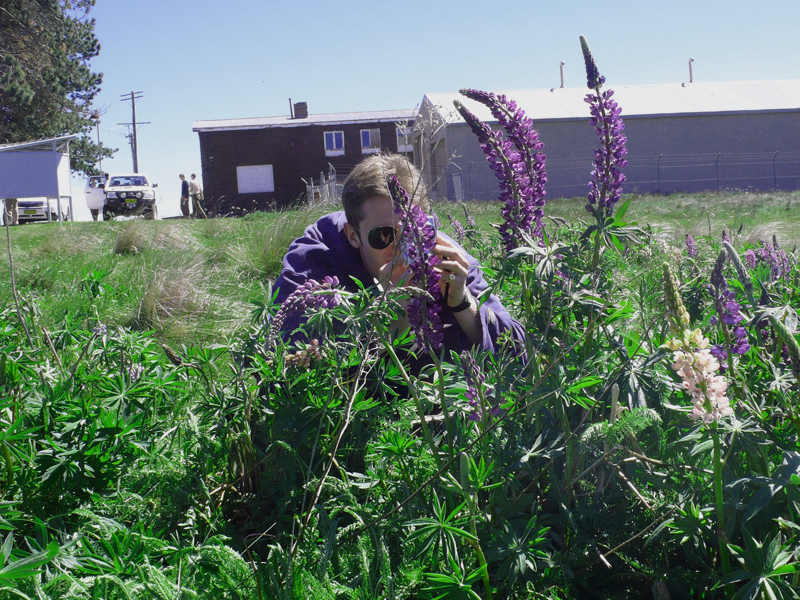So much for pristine mountainscapes
In every mountainous region in the world, researchers find plants that come from other continents and become serious competitors for the indigenous species. Preventing these invasive species from elbowing out the native species calls for control – which frequently means getting your hands dirty.

All over the world, invasive species are on the offensive. Invasive plants alter ecosystems and threaten native biodiversity. The most conspicuous examples of invasive plants in Switzerland are goldenrod (Solidago spp.) from North America which is invading species-rich reed meadows in nature reserves, and the Himalayan balsam (Impatiens glandiflora) and Japanese knotweed (Reynutria japonica) from East Asia which thrive along rivers and streams.
Invasive organisms also threaten native diversity on other continents and oceanic islands hard hit examples include the Seychelles or Australia. European settlers released numerous plants and animals, which replaced the indigenous flora and fauna, and now threaten the unique biodiversity.
No mountain too high?
Researchers fear that alien plant species are also increasingly colonizing mountain regions and disrupting their sensitive ecological balances. This fear is not unfounded in some mountains regions of the world non-native plants have out competed the indigenous species, sometimes with serious consequences for the ecosystems.
In some areas of the Andes in Central Chile, the European dandelion (Taraxacum spp) is dominant. It settles in cushion plants and ousts the indigenous plants that also thrive in them. More importantly, its large, bright yellow petals attract more insects than its indigenous counterparts, which are ultimately starved of pollinators.
Certain mountainsides in Hawaii are covered entirely by European grasses. Hardly any native species are able to grow there any more. And in the Australian Alps, the orange hawkweed (Hieracium antiacium) has established to such an extent that the national park authorities fear it could spread as much as it has New Zealand. Therefore authorities are using preventive measures to contain the plant.
100 being contained
A glance at the data from the ETH-Zurich-affiliated Mountain Invasion Research Network (MIREN) reveals that globally 1,500 plant species are known to be potentially invasive in the mountains of the world. 100 of them are now being contained, in many cases, including hawkweed, purely as a precautionary measure.
The primary cause of invasions by alien plants is man. “Exotic species” or alien species are introduced for ornamental gardens around hotel complexes and tourist infrastructure. This is increasingly occurring in mountain regions, which until recently had been unaffected. These garden plants often come from other alpine regions of the world and are accustomed to harsh climates. “Plants which humans introduce deliberately seem to become a problem more frequently than those that have spread accidentally”, explains Christoph Küffer, a senior assistant at the Institute for Integrative Biology and MIREN coordinator.
Invasion by road and rail
Railway lines or mountain pass roads serve as corridors for alien species into the mountains. Invasive plants thrive under disturbed conditions along transport axes where the debris created by the construction of roads and railways, or carved-out banks and gravel roadsides provides suitable habitat.
Comparatively speaking, the situation in the Swiss Alps still seems harmless. “There is still no evidence that invasive plants are responsible for the extinction of any native species”, says Tim Seipel, a PhD student from the Institute of Integrative Biology. He is currently investigating how and where alien species invade in the Swiss Alps.
Higher Altitudes are resistant
In 2009, he surveyed 230 sites along roads and railways in the Swiss Alps and compared the data to 2003 when the survey was originally conducted. His preliminary conclusion is that non-native plants that have already been in Switzerland for some time and are subsequently abundant in the lowlands are to be found at greater altitudes than those which appeared only recently. On the other hand, most species did not manage to spread to higher altitudes between 2003 and 2009, and the range of invasive species shrinks as the altitude increases. At 2,000 meters above sea level, barely half a dozen species are able to survive.
One plant with the potential to become invasive in the Swiss mountains is a popular garden flower: the Large-leaved lupine. Originally from the Pacific Northwest region of America, it was introduced in Germany 170 years ago and has been found in Switzerland for about 70 years. In the native range the summers are cool and rainy and there is a lot of snow in the winter similar to the Swiss Alps. The lupine feels at home above 1,300 meters above sea level, which helps it establish outside of domestic and hotel gardens.
Large-leafed Lupine (Lupinus polyphyllus) dominates a meadow at the Schatzalp above Davos. The botanist found Large-leaved lupines have also appeared outside a hotel garden along the Furka Pass and are spreading from a garden. These occurrences are still localized and do not pose a threat to the native flora. Nevertheless, the scientists still want to keep an eye on them. “It’s much easier to combat invasive species before they spread”, says Küffer. Small numbers can be brought under control relatively quickly and reliably. That said, the plants often have to be painstakingly pulled out and disposed of individually, especially in mountainous regions.
Controlling trade
As far as Küffer is concerned, we need to analyze the risks involved in the behavior of plants destined for the horticultural trade and monitor the transport channels for garden plants more efficiently if we are to be successful in combating invasive species. In many countries, there is a huge pool of potential garden plants that have not yet been introduced to the Swiss Alps but may be attractive for gardening. “Research, nature conservation and horticulture have to work together to more effectively prevent future invasions of unwelcome species”, says Küffer.
MIREN turns five
The Mountain Invasion Research Network (MIREN) was founded at ETH Zurich in 2005 and is coordinated by Christoph Küffer. The organization researches and monitors the invasion of alien species in mountain regions all over the world. Scientists have been using a uniform approach to compile data on invasive plants in the world’s mountains. MIREN consists of scientists from academia and from managers of nature reserves. Five years on, the parties involved have taken stock in the specialist journal “Frontiers in Ecology and Environment” and published a review on invasive species in mountain regions. The network’s next move will be to publicize their findings. MIREN also uses invasions in mountains as a model system for basic research in ecology to understand evolutionary processes along climate gradients better.
References
Pauchard A, Küffer C, Dietz H, Daehler CC, Alexander J et al. Ain’t no mountain high enough: plant invasions reaching new elevations. Front Ecol Environ 2009; 7(9): 479-486. doi:10.1890/080072.










READER COMMENTS